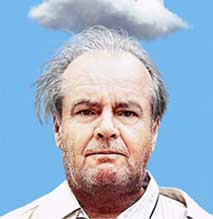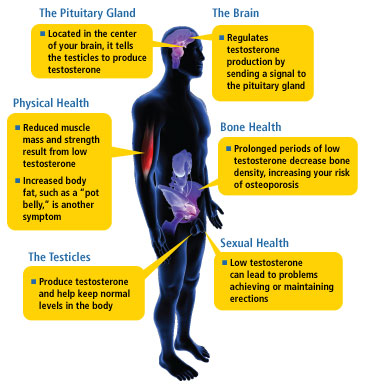Are you someone who had never heard of Low-T until recent commercials starting telling you that you weren’t normal? Let’s review what all the fuss is about.
As most people know, testosterone is the most important male sex hormone that in many ways and for many defines “manhood,” contributing to the following:
- Changes of puberty, including deepening of your voice
- Production of pubic, facial and body hair
- Production of sperm
- Facilitation of sex drive
- Maintenance of bone health, which assists growth
In case you were wondering, this is what “male menopause” looks like.
Certain parts of the brain (hypothalamus and pituitary gland) signal how much testosterone needs to be produced. Most production occurs in the testes.
The symptoms of low testosterone are predictable. Symptoms include a reduction in sex drive, erections and sperm count. Men may also see an enlargement of their breasts. Additional symptoms (over the long-term) may include smaller testes, less energy, mood changes, loss of muscle size and strength, and weakened bones.
The aging process normally reduces sex drive, sperm count and frequency of erections. Aging also reduces testosterone such that clinically low testosterone levels invariably occur by age 70. The presence of these two independent facts can make it confusing to know if these symptoms are simply part of the aging process or might be attributable to a disease in the areas that either produce or regulate testosterone. In other words, although a natural age-related reduction in testosterone level is normal, it may or may not be the cause of lower sex drive.
Low testosterone in the absence of aging really is thought to be more of a sign of disease than a disease unto itself. The primary goal is to ensure than none of the more serious causes of low testosterone are present. Some of the more serious causes and considerations leading to low testosterone include injury, infection or cancer to the testes, radiation therapy or chemotherapy, hormonal disorders such as pituitary gland tumors or diseases, liver and kidney disease, diabetes, HIV/AIDS, obesity, certain genetic disorders and use of opiates (pain-killers).
Based on the cause and your health status, you may be prescribed testosterone replacement therapy. Testosterone replacement may occur via periodic injections, skin patches/gels, skin pellets or tablets that stick to the gums.
Testosterone replacement is not like taking a pill for an erection. These are hormones and come with long-term risks, the most notable being prostate cancer. Therefore, those males with prostate or breast cancer aren’t candidates for testosterone replacement therapy. Other side effects of testosterone replacement therapy include acne, breast enlargement, fluid buildup in the legs, ankles and feet, increased red blood cell count, prostate enlargement and sleep apnea.
Here are groups with significant enough risks from testosterone replacement therapy that they require monitoring if treated this way:
- African-American men
- Men over 40 years of age who have close relatives with prostate cancer
- All men over 50 years of age
So what should you do with this information?
- Understand that certain age-related changes occur naturally and don’t represent disease.
- Understand that the premature presence of these symptoms could represent disease and need to be evaluated.
- Understand that a desire to avoid the symptoms associated with low testosterone is best done with routine health measures (diet and exercise) that help the body function and maintain healthy levels of testosterone naturally.
- Understand that a decision to seek treatment for these symptoms isn’t as simple as getting a pill or a patch. Hormonal treatment has real and serious associated side effects and risks and should only be done with the consultation and consent of your physician and endocrinologist (hormone specialist).
Feel free to contact your SMA expert consultant for any questions you may have on this topic.
Thanks for liking and following Straight, No Chaser! This public service provides a sample of what http://www.SterlingMedicalAdvice.com (SMA) offers. Please share our page with your friends on WordPress, Facebook @ SterlingMedicalAdvice.com and Twitter at @asksterlingmd.
Copyright © 2014 · Sterling Initiatives, LLC · Powered by WordPress







I like the valuable information you provide on your articles. I’ll bookmark your blog and check again right here frequently. I am fairly certain I’ll learn many new stuff proper here! Good luck for the following!
Thank you for the kind words and for following Straight, No Chaser!